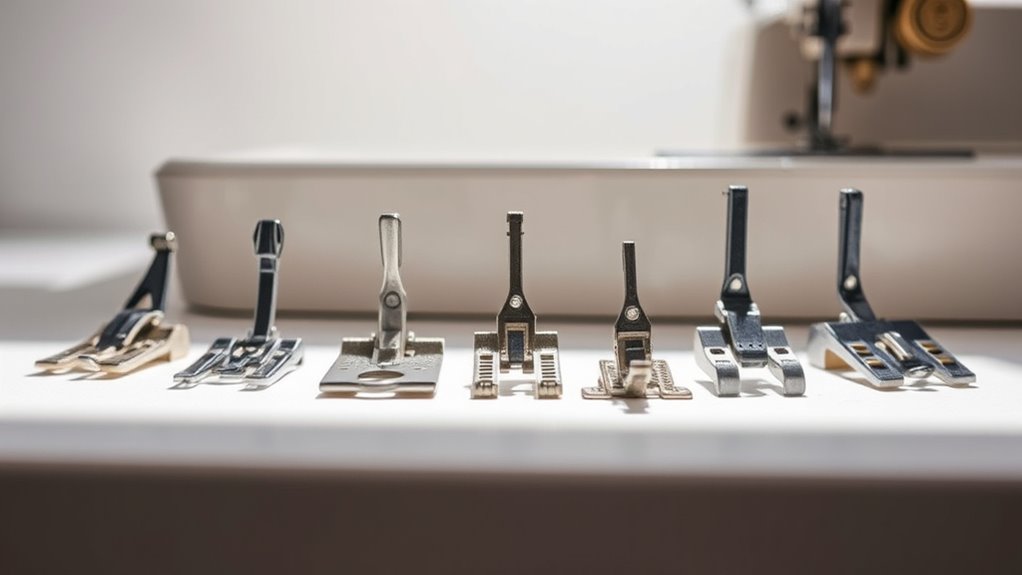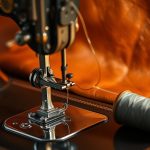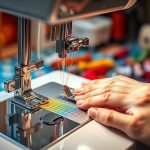Sewing machine feet aren’t universal; their compatibility varies greatly among brands like Brother, Singer, and Janome. Each type of foot is designed for specific tasks, and factors like shank types can further limit interchangeability. For instance, low shank feet won’t fit high shank machines. If you’re not careful, you might run into sewing issues. Understanding foot types and compatibility can improve your sewing projects, and there’s more to uncover about making informed choices.
Understanding Sewing Machine Feet
Sewing machine feet are essential tools that can dramatically enhance your sewing experience. Understanding their functionality features is vital for achieving the best results. Each foot type is designed for specific tasks, whether you’re working with zippers, hems, or decorative stitches.
The materials used in these feet, such as plastic or metal, also play a significant role in their durability and performance. For instance, metal feet tend to provide better stability, especially when working with thicker fabrics. Conversely, plastic feet are often lighter and easier to manage, making them ideal for intricate work.
By familiarizing yourself with these aspects, you’ll be better equipped to choose the right foot for your projects, ultimately improving your sewing efficiency and creativity.
Types of Sewing Machine Feet
When it comes to sewing machine feet, you’ll find a variety designed for specific tasks, each enhancing your sewing experience. Understanding the functions of different presser feet and specialty feet can greatly improve your projects, while also considering their compatibility with your machine. Let’s explore the key types and their unique benefits.
Types of Presser Feet
Presser feet are essential tools that considerably enhance a sewing machine’s versatility and functionality. Understanding the different types of presser feet allows you to choose the right one for your projects, ensuring precision and ease. Each foot varies in design, materials, and attachment methods, making it vital to know their specific uses.
- Zipper Foot: Perfect for sewing zippers closely to the fabric edge.
- Walking Foot: Ideal for quilting, it feeds multiple layers evenly.
- Buttonhole Foot: Facilitates the creation of perfectly shaped buttonholes.
- Blind Hem Foot: Enables discreet hemming for a polished finish.
Specialty Feet Functions
Many specialty feet are designed to tackle specific tasks, making your sewing projects more efficient and enjoyable. There are various specialty foot types, each offering unique foot functions that can enhance your sewing experience. For instance, a walking foot guarantees even feeding of multiple layers, perfect for quilting.
A zipper foot allows you to sew close to the zipper teeth, providing a professional finish. The buttonhole foot simplifies creating consistent buttonholes, while a free-motion quilting foot enables artistic designs without restriction.
Using these specialty feet not only improves accuracy but can also save you time and effort, helping you achieve professional-looking results with ease. Embrace these tools to elevate your sewing skills and creativity.
Compatibility With Machines
While it’s essential to choose the right sewing machine feet for your projects, understanding their compatibility with your specific machine is equally important. Different machine brands often require specific types of feet, and not all feet are interchangeable. Here are a few factors to take into account:
- Machine Brands: Verify the foot is designed for your sewing machine brand, such as Brother, Singer, or Janome.
- Foot Materials: Different materials, like plastic or metal, can affect durability and performance.
- Foot Types: Identify if you need snap-on or screw-on feet, as these vary by machine.
- Compatibility Lists: Check manufacturer guidelines for lists of compatible feet.
Compatibility Among Different Brands
When it comes to sewing machine feet, compatibility can vary considerably among different brands. While some manufacturers use standardized mounting systems that allow for cross-brand compatibility, others have specific designs that limit interchangeability. Additionally, specialty feet often come with unique features tailored to a particular machine, making them less versatile across different models.
Brand-Specific Designs
Although sewing machine feet may seem universally interchangeable, brand-specific designs often present challenges in compatibility. Different manufacturers create unique attachments tailored to their machines, leading to significant design variations. This means you might find that a foot from one brand doesn’t fit another, even if they look similar.
Consider the following factors when evaluating brand compatibility:
- Attachment Mechanism: Each brand may use a distinct method for attaching feet.
- Foot Shape and Size: Variations can affect stitch quality and functionality.
- Material and Durability: Brands often use different materials, impacting performance.
- Additional Features: Some feet come with specific features that may not align with other machines.
Understanding these nuances is essential for effective sewing.
Standardized Mounting Systems
As you explore the world of sewing machine feet, you’ll discover that some manufacturers have adopted standardized mounting systems, which can enhance compatibility across different brands. This means you may be able to use a variety of feet, even if they come from different manufacturers. However, there are still some mounting system variations that can complicate matters.
Here’s a quick comparison of common mounting systems:
| Brand | Mounting System Type |
|---|---|
| Brother | Snap-on |
| Janome | Clip-on |
| Singer | Low shank |
| Bernina | High shank |
Utilizing standardized attachments can simplify your sewing experience, but always check compatibility before purchasing new feet to guarantee they fit your machine.
Specialty Feet Limitations
While many sewing enthusiasts appreciate the versatility that specialized feet can bring to their projects, compatibility issues often arise when attempting to use these attachments across different brands. Specialty foot limitations can hinder your sewing experience, leading to frustration rather than creativity. Here are some compatibility challenges you might face:
- Mounting System Variations: Different brands have unique attachment mechanisms.
- Design Specifications: Specialty feet may vary in size and shape across brands.
- Functionality Restrictions: Some feet are designed for specific machine capabilities.
- Material Differences: The quality and type of materials can affect performance.
Understanding these limitations can save you time and effort, ensuring you choose the right feet for your machine and projects.
The Importance of Shank Types
Understanding shank types is crucial for any sewing enthusiast, as they directly affect the compatibility and functionality of sewing machine feet. Shank compatibility is determined by the measurement of the shank, which varies among different brands and models. There are generally three types: low, medium, and high shanks.
If you don’t match the shank measurement to your machine, you risk improper attachment, leading to sewing issues or even damage. For example, a low shank foot won’t fit correctly on a high shank machine.
Knowing your machine’s shank type guarantees you select the right feet for various tasks, from quilting to hemming, enhancing your sewing experience and allowing you to achieve professional results with ease.
Universal Feet: What You Need to Know
Knowing your machine’s shank type opens the door to exploring universal sewing machine feet, which are designed to fit a variety of machines and projects. These feet enhance your sewing experience by providing versatility across different sewing foot types. Here’s what you should keep in mind regarding attachment compatibility:
- Versatility: Universal feet often work with multiple brands, saving you money.
- Functionality: Each foot serves specific purposes, from quilting to zippers.
- Quality: Opt for well-reviewed feet to guarantee durability and performance.
- Compatibility: Always double-check shank type and fitting before purchasing.
Adapting Feet for Various Machines
Adapting sewing machine feet for various machines can greatly enhance your sewing capabilities. To achieve this, you’ll need to understand adapting foot compatibility between different brands and models.
Many machines have specific fittings, but with a bit of creativity, you can customize foot attachments to work on your machine. For instance, using adapter plates can help bridge the gap between different foot types and your sewing machine. Additionally, consider modifying the shank to fit your machine’s specifications.
Always verify that the feet you choose are safe to use and won’t damage your machine. By exploring these options, you’ll release a broader range of techniques and projects, making your sewing experience more enjoyable and versatile.
Buying Tips for Sewing Machine Feet
How do you guarantee you’re buying the right sewing machine feet for your projects? Start by considering the specific needs of your sewing tasks. Here are some tips to help you make an informed choice:
- Foot Material Options: Look for durable materials like metal or high-quality plastic that suit your sewing style.
- Compatibility: Verify the feet are compatible with your machine’s make and model.
- Attachment Ease: Choose feet that are easy to attach and detach, saving you time during your projects.
- Functionality: Assess the feet’s functions, such as quilting, zipper insertion, or buttonholes, to meet your project requirements.
Common Misconceptions About Sewing Feet
Despite the careful considerations you’ve made in choosing the right sewing machine feet, misconceptions can still cloud your understanding of their functionality. Here are some common myths that may mislead you:
| Myth | Truth |
|---|---|
| All feet fit all machines | Feet are often specific to machine brands/models |
| Expensive feet are better | Quality varies; price isn’t the only factor |
| Using the wrong foot will break your machine | Most machines are designed for versatility |
| You can’t mix brands | Many feet are compatible across different brands |
Understanding these sewing misconceptions helps you make informed choices, ensuring you get the most out of your sewing experience. Don’t let these common myths limit your creativity or sewing potential!
Frequently Asked Questions
Can I Use Old Sewing Machine Feet on a New Machine?
You can’t always use old sewing machine feet on a new machine due to compatibility issues. Different models have unique foot attachments, so it’s best to check your machine’s specifications before attempting to interchange them.
What Materials Are Sewing Machine Feet Typically Made From?
Sewing machine feet are typically made from various plastic types for lightweight uses and durable metal alloys for heavy-duty applications. The choice of material affects performance, compatibility, and longevity, so consider your sewing projects carefully.
How Do I Clean and Maintain My Sewing Machine Feet?
“An ounce of prevention’s worth a pound of cure.” To clean your sewing machine feet, use gentle cleaning techniques like warm soapy water and a soft brush. Regular maintenance tips keep them in top shape for sewing success.
Are There Sewing Feet Designed Specifically for Quilting?
Yes, there are sewing feet designed specifically for quilting. A walking foot is essential for quilt piecing, as it helps guide multiple fabric layers evenly, preventing shifting and ensuring precise stitching for beautiful quilt projects.
Can I Modify a Sewing Machine Foot for Better Fit?
About 75% of sewers customize their tools. You can definitely modify a sewing machine foot using foot modification techniques or creating custom foot designs, enhancing your sewing experience and achieving better fit for your projects.


